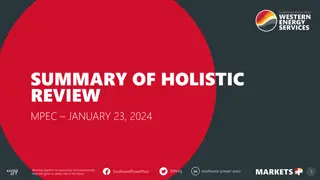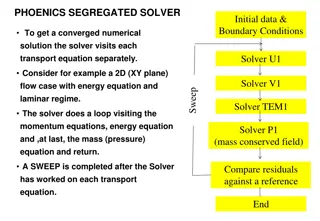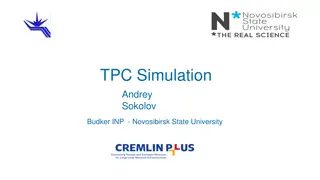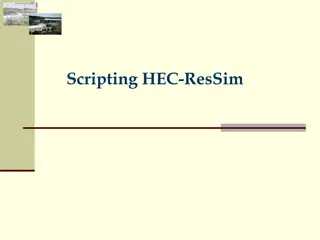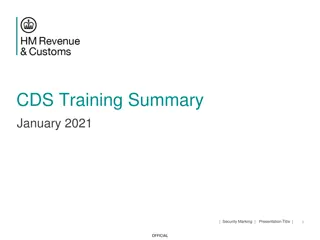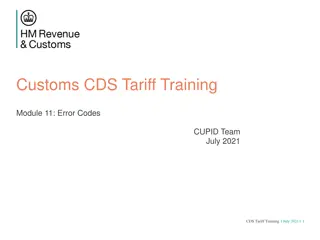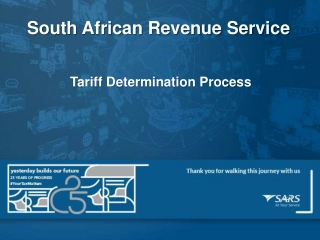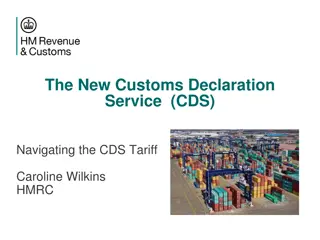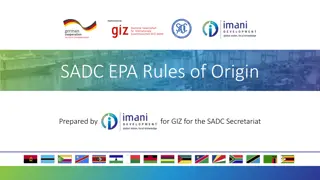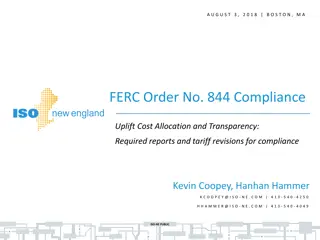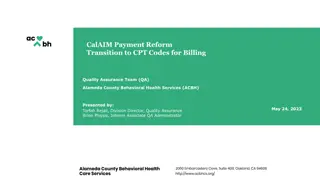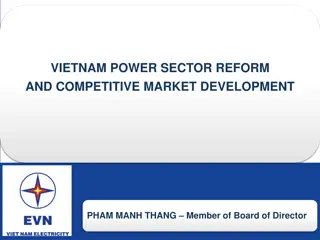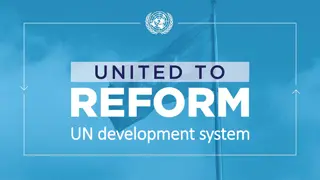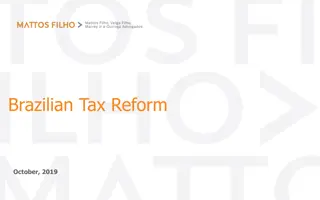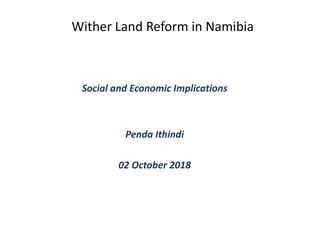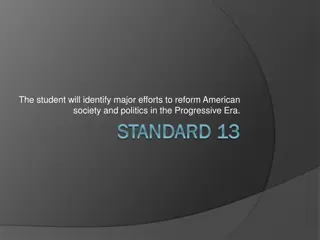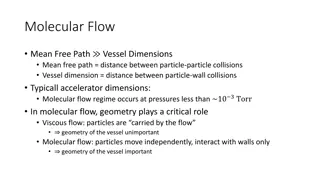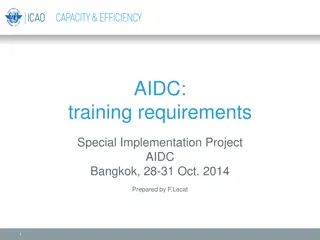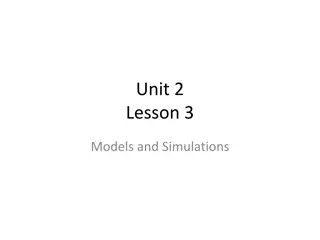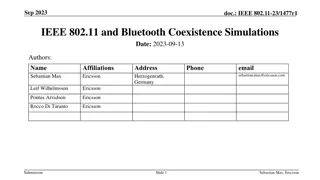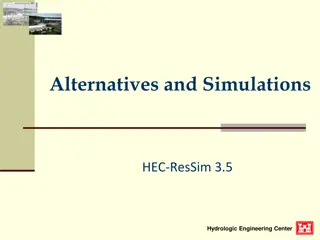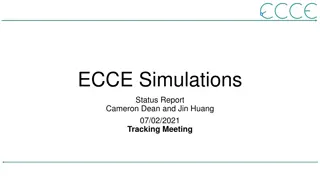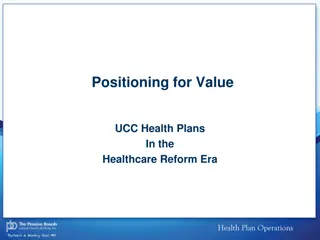Understanding Tariff Reform Simulations Using UTAS
This presentation introduces tariff reform simulations using UTAS in the context of the car economy example. It covers how tariffs on imported goods impact production costs and effective protection of domestic industries. Key concepts such as output tariff, upstream tariff, and effective protection are explained with practical examples.
Download Presentation

Please find below an Image/Link to download the presentation.
The content on the website is provided AS IS for your information and personal use only. It may not be sold, licensed, or shared on other websites without obtaining consent from the author. Download presentation by click this link. If you encounter any issues during the download, it is possible that the publisher has removed the file from their server.
E N D
Presentation Transcript
INTRODUCTION TO TARIFF REFORM SIMULATIONS USING UTAS JANUARY 2022, PAKISTAN BUSINESS COUNCIL Federico Ganz fganz@worldbank.org
1 Before we begin... 1. Please, mute your microphone 2. If you have a question, please raise your virtual hand
2 THE CAR ECONOMY EXAMPLE Assume we have a very simple economy that has only three industries: Steel production, Engine manufacturing and Car manufacturing. Let s also assume that the Steel industry uses no inputs (all the output is value added), that the Engine industry uses steel (only input) and value added, and that the Car industry uses engines (only input) and value added. Assume that steel and engines can be imported, and that cars are only sold to final consumers (cars are not used as production inputs). DOMESTIC STEEL (100% VA) DOMESTIC CAR (60% ENGINE, 40% VA) DOMESTIC ENGINE (80% STEEL, 20% VA) VA: VALUE ADDED
3 EXAMPLES OF QUESTIONS THAT CAN BE ADDRESSED WITH UTAS Assume that tariffs on imported steel are raised... How would that affect the production costs of the domestic engine industry? And of the domestic car industry? DOMESTIC STEEL (100% VA) DOMESTIC CAR (60% ENGINE, 40% VA) ??? DOMESTIC ENGINE (80% STEEL, 20% VA) VA: VALUE ADDED
4 EXAMPLES OF QUESTIONS THAT CAN BE ADDRESSED WITH UTAS Assume that tariffs on imported steel are raised... How would that affect the effective protection of the domestic steel industry? And of the domestic engine and car industries? DOMESTIC STEEL (100% VA) DOMESTIC CAR (60% ENGINE, 40% VA) TARIFF? +TARIFF ON IMPORTED STEEL COSTS? TARIFF? COSTS? EFFECTIVE PROTECTION? EFFECTIVE PROTECTION? TARIFF? COSTS? EFFECTIVE PROTECTION? DOMESTIC ENGINE (80% STEEL, 20% VA)
5 THREE KEY CONCEPTS 1. Output tariff: tariff applied to the imported variety. Example of the engine industry: the tariff applied to imported engines. 2. Upstream tariff: tariffs applied to inputs used to produce the good. Example of the engine industry: the tariff applied to imported steel. 3. Effective protection: is the difference between the output tariff and the upstream tariff.
6 DIRECT AND INDIRECT INPUTS While the car does not use steel directly, it does have steel embedded in the engine Does a tariff on steel affect the cost of producing cars? It depends on whether domestic and foreign engines are perfect substitutes or not DOMESTIC STEEL (100% VA) DOMESTIC CAR (60% ENGINE, 40% VA) ??? DOMESTIC ENGINE (80% STEEL, 20% VA) VA: VALUE ADDED
7 UTAS offers two frameworks: 1. PRODUCT HOMOGENEITY: Domestic and imported inputs are perfect substitutes. Example: the tariff on steel will not affect the cost of engines car manufacturers face (they can always buy the imported variety, which is unaffected by the tariff imposed on steel). Therefore, the cost of producing cars is not affected. An industry s production costs are only affected by direct inputs. 2. PRODUCT DIFFERENTIATION: Domestic and imported inputs are imperfect substitutes. Example: the tariff on steel will affect the cost of imported engines, and therefore the cost of producing cars is affected. An industry s production costs are affected by direct AND indirect inputs.
8 What inputs do we need to analyze the impact of a tariff reform on production costs and on effective protection?
9 (1) Tariffs (customs data) (2) Structure of the economy (input-output tables) (3) Parameters (chosen by the researcher) STEEL INDUSTRY (100% VA) CAR INDUSTRY (60% ENGINE, 40% VA) Parameters Remember that for the product differentiation framework we needed to specify the initial varieties mix, the substitution elasticity and the domestic variety s supply elasticity. An input-output table allows us to decompose each sector s output into intermediate consumption (inputs from other sectors) and value added by the sector ENGINE INDUSTRY (80% STEEL, 20% VA)
10 FORMATTING OF THE TARIFF SCHEDULE The tariff-schedule needs to be formatted in a specific way to load into UTAS At HS 10, 8, or 6-digits Column A - HS product code Column B - Baseline Tariff HS codes should follow ????.?????? ????.???? ????.?? format. "0101.2100" 7.7 "0101.2900" 3.0 Tariffs in percentage points. "0101.3000" 0.0 "0101.9000" 4.7 Researcher choice: nominal tariffs or effectively applied tariffs (collected/imports)? "0102.2110" 0.0 "0102.2120" 5.0 "0102.2130" 0.0
11 INPUT-OUTPUT TABLES: WHAT ARE THEY? Input-Output tables represent how different sectors in an economy depend one other via input-output relationships. UTAS is flexible with respect to the industry classification that can be used, presenting three alternatives: GTAP, ISIC or NAICS. However, the data must be formatted in a specific way: if there are N sectors (57 in the GTAP case), then the matrix should have N columns and N+3 rows (one row per sector + total intermediate consumption, total value added and total industry output). Moreover, the names of the industries must be exactly equal to the names UTAS uses (they vary according to the classification chosen). We will provide an Excel file with this information.
12 CONCORDANCE FROM PRODUCTS TO SECTORS Note that tariff data is available at the product level (e.g., HS 6 or 8 digit), while input- output tables are at the GTAP sector (industry) level. THE UTAS TOOL MATCHES THE TARIFF DATA AT THE PRODUCT LEVEL WITH THE SECTORS USING A CONCORDANCE TARIFF LINES (PRODUCT LEVEL) INDUSTRIES (GTAP) CONCORDANCE 100610 Cereals; rice in the husk 720610 Iron or non-alloy steel; ingots 720690 Iron or non-alloy steel; primary forms 840731 Engines; reciprocating piston engines 870332 Vehicles; w/ only compression-ignition... PDR - Paddy rice I_S - Ferrous metals MVH - Motor vehicles and parts Practical note. Unfortunately, there is no perfect match for the industries in our example ( Steel , Engine and Car ) and the 57 sectors available in GTAP (the IO table we have available for Pakistan). For example, both finished vehicles and car parts are classified in the same broad sector Motor vehicles and parts in GTAP. Moreover, steel products are classified in the broad category Ferrous metals . This is one of the limitations of the tool: the level of disaggregation of the results will be limited by the sectors included in the classification chosen (GTAP in this case).
13 STRUCTURE OF THE TOOL INPUT Assumptions Modules Output HS code tariff ranking Input-Output data Tariff- Ranking Sector specific analysis Simulator 1 Baseline tariff data Cross- sector analysis Framework choice & parameters Simulator 2 Tariff reform scenarios Tariff scenario analysis Simulator 3
14 SIMULATION MODULES UTAS has four simulation modules that allow us to answer four different questions: Tariff-ranking module: What tariff lines of the HS tariff schedule have a particularly large impact on the cost structure in a prioritized sector? SIM I module: How does a change in input tariffs affect the cost structure and the effective protection in one specific sector? SIM II module: What is the impact of a change in input tariffs across several sectors? SIM III module: What is the impact of a change in the tariff schedule at the product level?



